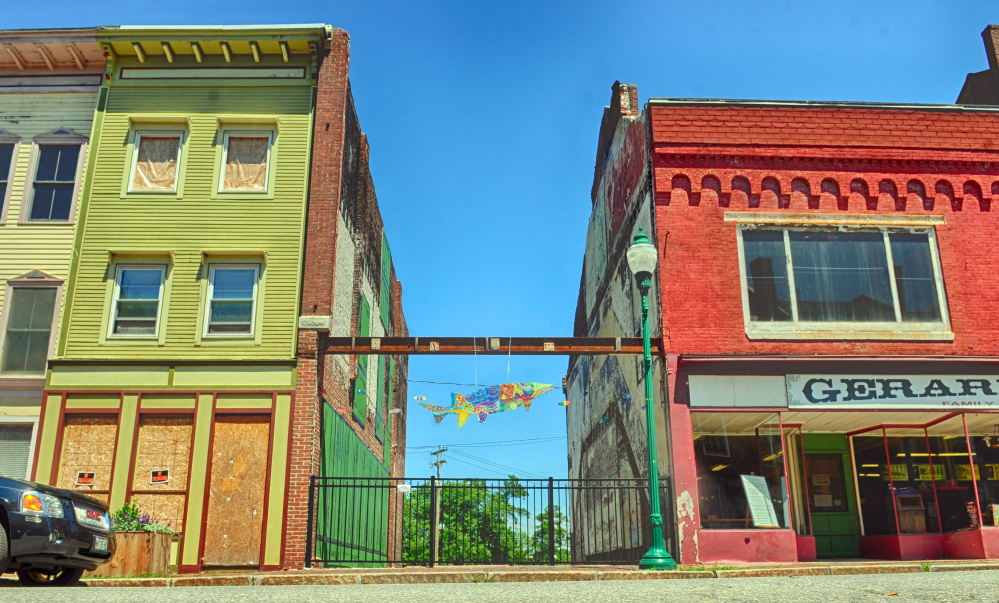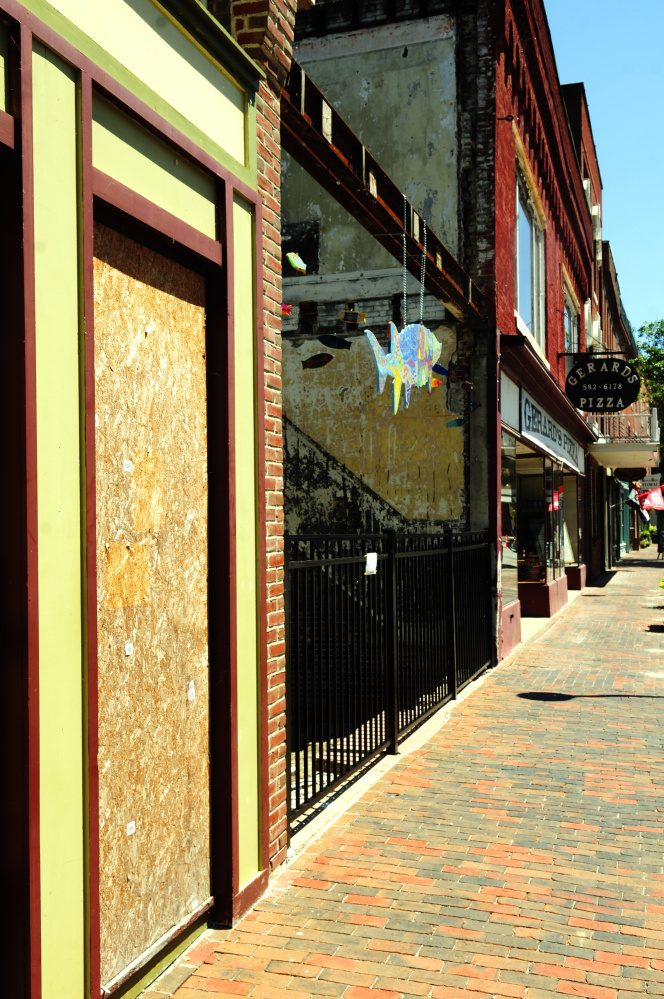GARDINER — Boarded-up windows and a vacant space are the only indications that remain of the fire that destroyed one building and damaged four others one year ago in downtown Gardiner.
“There’s certainly a personal sadness for me every time I walk or drive by that empty space,” Gardiner Mayor Thom Harnett said recently. “Losing a piece of downtown is like losing a piece of the Gardiner family.”
The July 16 fire, Harnett said, made people think of downtown Gardiner in a different way.
“It showed how important it is to our economy,” he said. “It’s what makes Gardiner a city and a place for people to congregate, and people have picked up on that.”
Before the fire, Water Street had been the focus of community development efforts, with new retail businesses such as the Gardiner Co-Op and the Touch of Grey tattoo salon moving into street-level spaces and planned renovations to other buildings such as Johnson Hall in the works.
All of that activity and momentum appeared to grind to a halt shortly before 4:30 that warm Thursday afternoon, when the first firetrucks arrived.
The only indication that something was wrong was the drift of smoke that seeped out of the front of 235 Water St.
The story from the back side of the building, the side that faces the Arcade parking lot and Cobbosseecontee Stream, was very different. Shortly before 4:30 p.m., heavy fire was showing from a second-floor window in the rear and the smoke detectors in the buildings were shrieking.
For the next eight hours, the Gardiner Fire Department, joined by units from Augusta, Togus, Pittston, Randolph and Farmingdale, then Hallowell, West Gardiner, Litchfield, Winthrop, Winslow and Topsham, worked to knock down and put out the fire, but not before it spread west into 243 and 251 Water St., and not before the roof of 235 caved in.
“I’ve been at bigger fires,” Gardiner Fire Chief Al Nelson said earlier this week, sitting in the relative quiet of the fire station just off Church Street. When downtown fire broke out, Nelson had been fire chief in Gardiner for less than a year. He had retired in 2009 as battalion chief from the Augusta Fire Department and worked as a nurse for a few years at VA Maine Healthcare Systems at Togus before he was hired in Gardiner.
But the downtown Gardiner fire, coming only months after the fire that destroyed half of Highland Terrace, a senior apartment complex, presented tactical challenges he hadn’t seen before as an incident commander. Because the building was in the middle of a block of connected buildings, it was fought on two sides and with only radio communication between Nelson and Jason Farris, battalion chief at the Augusta Fire Department.
In the fire’s immediate aftermath, when some of the building’s occupants were unaccounted for, the focus was on searching the rubble. Eventually, those residents were found safe, but they had lost everything they owned. The cause of the fire was undetermined.
A year later, the remains of 235 Water St. have been knocked down and hauled away. All that remains is a beam that bridges the gap between Gerard’s Pizza at 227 Water St. and the fire-damaged building at 243.
The beam is the home to an art installation of a painted sturgeon and alewives that’s a collaboration of SpinOff Studio, Gardiner Main Street’s streetscape team, and Upstream, a nonprofit dedicated to restoring the alewife run to Cobbosseecontee Stream.
The buildings at 243 and 251 Water St. remain vacant and boarded up.
“It’s a miracle we have any buildings in downtown Gardiner when you look at the history,” said Patrick Wright, the executive director of Gardiner Main Street and economic development coordinator for the city.
HISTORIC FIRES
In many ways, fire has shaped and reshaped Gardiner’s downtown for decades. The archive in Gardiner Public Library contains accounts of fires large and small dating back to the 19th century, when fires were fought with bucket brigades. Historic photos show buildings in and around downtown Gardiner that no longer exist, mostly because they burned.
In 1860, a fire broke out in a sawmill on the First Mile Bridge, burning five mills, all the shops and other buildings on the bridge and homes on High and Summer streets.
The great fire of 1882 burned over the same area, although more property was destroyed. A second fire that year burned at the lower end of Water Street.
A century ago, Gray’s mill, the Gray-Hildreth grist mill, the Oakland Co. planing mill and the woolen mill burned.
The American Tissue plant was flattened by fire in 1970, fire destroyed a block of buildings in 1985 on the site of what’s now McKay Park, and the Yorketown paper mill was torched in 2009.
Jessica Lowell can be contacted at 621-5632 or:
jlowell@centralmaine.com
Twitter: @JLowellKJ
Copy the Story LinkSend questions/comments to the editors.





Success. Please wait for the page to reload. If the page does not reload within 5 seconds, please refresh the page.
Enter your email and password to access comments.
Hi, to comment on stories you must . This profile is in addition to your subscription and website login.
Already have a commenting profile? .
Invalid username/password.
Please check your email to confirm and complete your registration.
Only subscribers are eligible to post comments. Please subscribe or login first for digital access. Here’s why.
Use the form below to reset your password. When you've submitted your account email, we will send an email with a reset code.